In recent years, Vietnam has emerged as one of the leading suppliers for global garment sourcing, positioning itself as a crucial player in the textile and apparel industry. Several factors have contributed to this rise, from favorable trade agreements to its strategic response to global shifts in supply chain management.
Key Drivers Behind Vietnam's Growth
Trade Agreements and Market Access Vietnam's participation in multiple free trade agreements (FTAs), such as the Comprehensive and Progressive Agreement for Trans-Pacific Partnership (CPTPP) and the EU-Vietnam Free Trade Agreement (EVFTA), has significantly enhanced its access to key markets. These agreements have lowered tariffs on Vietnamese garments, making the country a more competitive option for global brands looking to optimize costs.
Strategic Geographic Location Positioned in Southeast Asia, Vietnam benefits from proximity to China, the world's largest textile producer, while offering an alternative for brands looking to diversify their sourcing away from China. This geographic advantage allows Vietnam to access raw materials quickly, lowering production costs and lead times.
Competitive Labor Force Vietnam's labor market is known for being both cost-effective and skilled in garment manufacturing. While labor costs in Vietnam have risen in recent years, they are still lower than in China, making the country an attractive destination for companies seeking quality production at competitive prices.
Resilient Supply Chains The global pandemic disrupted supply chains worldwide, causing many companies to reevaluate their reliance on specific regions. Vietnam, with its relatively stable handling of the crisis and quick recovery, became a focal point for garment sourcing. The country’s ability to maintain production during challenging times further solidified its reputation as a reliable supplier.
Sustainability and Innovation Vietnam is increasingly focusing on sustainable production practices, a growing concern for global brands. Many factories are investing in eco-friendly technologies and processes, such as water-saving dyeing methods and using renewable energy sources. These steps align with the sustainability goals of many Western brands and appeal to a more environmentally conscious market.

Challenges and the Path Forward
While Vietnam's rise in the global garment industry is undeniable, there are challenges ahead. The country still depends on imported raw materials, primarily from China, which can expose it to fluctuations in supply and costs. Additionally, rising labor costs may reduce its competitive edge in the long term.
The textile machinery industry has seen a number of innovations in recent years, resulting in a more efficient and productive sector. Here are some of the benefits of investing in the textile machinery industry:
1.Increased Efficiency
New machines and technologies have made the textile industry more efficient, thereby reducing costs and increasing profits.
2.Improved Quality
The latest machines and technologies allow for better quality control, leading to improved product quality.
3. Higher productivity
The newer machines can handle larger workloads in shorter timeframes, leading to increased productivity.
4. Greater Flexibility
The latest machines offer greater flexibility in terms of fabric handling and other operations, allowing for faster turnaround times and reduced production costs.
5.Enhanced Safety
The latest advances in machine technology have also resulted in enhanced safety features, protecting both workers and products.
To maintain its leadership, Vietnam will need to continue investing in automation, sustainability, and local raw material production. The country's focus on enhancing productivity and maintaining high-quality standards will be essential as global competition intensifies.
Conclusion
Vietnam’s journey to becoming a top global supplier in the garment industry is a testament to its strategic policies, competitive workforce, and forward-looking approach to sustainability. As the world of fashion sourcing continues to evolve, Vietnam is well-positioned to remain a key player, adapting to the demands of a changing global market.




